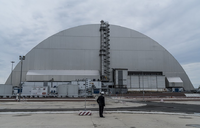Hadopelagic Crater
The Hadopelagic Crater is a massive pit in the Sacovia region of Caplona, near the border of Caradia. Originally discovered by Operation Heartland troops, the pit was subsequently put under investigation due to its extremely bizarre circumstances. The immediate inability to ascertain the depth of the pit gave the pit its name.
Upon further investigation using probes and remote sensors, the pit was determined to have a depth of roughly 6,587 metres, meaning it's lowest point reaches the depth of oceanic trenches. The pit seems to also possess an odd property that absorbs all light that enters it once it passes below a certain depth (roughly one kilometre), which prevented attempts to study the pit and ascertain its contents below one kilometre.
The pit is unnaturally devoid of life, including microscopic. Nothing living has been discovered inside the mouth of the pit. This has been attributed to the presence of acidic compound that is found to be secreted from the walls at various points. The source of the acid is as yet unknown.
The Scientific Consortium of Saint Baldur was sent by the Caradian government to investigate the pit. Dignitaries and officials in the organisation ordered the construction of a bunker around the pit in case of an anomalous and unforeseen disaster. After the completion of the containment dome, a military camp was subsequently built around the dome, which was called "Porțile Iadului", commonly referred to by its common tongue translation of "Hellsgate".
A probe was sent into the crater following the completion of the containment dome. The probe lost connection at roughly 300 metres down, and the scientists assumed the probe to be lost. The probe mysteriously reappeared next to the crater the next morning, covered in unknown biological tissue. At approximately noon that day, the crater began issuing gusts of hypothermic (-40 to -60 degrees) air every thirty minutes to two hours. The Ciric Confederacy sent a contingent of researchers to assess the crater and determine its properties following this incident.

